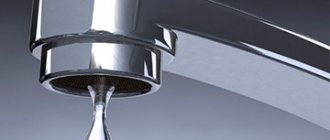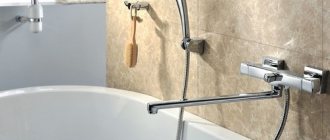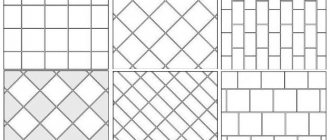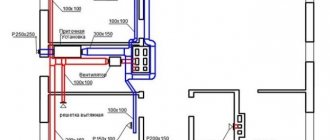A big mistake is made by those who, probably for reasons of economy, refuse to have a separate sink with a tap in the bathroom. There are similar “thrifty owners” who claim that a faucet installed on the bathtub is enough for them. Well, first of all, it’s not very convenient to wash your face or wash your hands regularly during the day over a bathtub. Secondly, it is much easier to tidy up the sink after, for example, brushing your teeth or washing heavily soiled hands after household chores. Why prematurely age an expensive bathtub? And thirdly, there is no need to put excessive load on the mixer with a bath shower - it will not last that long, and the saving effect will be zero, if not negative. So it makes more sense to install a separate plumbing fixture.
Bathroom sink faucet
The widest range of faucets on sale can even confuse an inexperienced buyer at first. On the one hand, what’s easier, since you can choose to suit every taste. But on the other hand, external data should not be the only criterion, and it is necessary to at least understand a little about the design, functionality and other features of this plumbing fixture. Therefore, a little “educational education” on how to choose a sink faucet for a bathroom would probably be appropriate.
And the key parameters of choice (besides purely aesthetic appeal, which, of course, is also very important) should be the reliability and durability of the mixer, ease of use, and its equipment with the necessary functions.
Selecting the right mixer
The faucet used in conjunction with the sink has, among others, such parameters as the length and height of the spout. They will be the main ones in the selection process and you need to focus on them. Typically, up to fifteen centimeters, this is a low spout; a high spout reaches a quarter of a meter. It is clear that the middle spout occupies an intermediate position. do, The tall mixer allows you to perform many different actions? The height of the device, reaching 30 cm and above, is needed for such operations as washing the bottom of a small child, washing a dog’s paws, or getting rid of dirt on shoes. With this mixer level you can even wash your hair in peace. If the mixer is installed on the wall, then it is important to first estimate at what angle the stream falls. This parameter will influence where and at what height the faucet will need to be installed relative to the sink.
Devices with a rotary aerator manufactured by Kludi are quite popular. They can vary the angle of the water jet with just a slight touch of a finger. Therefore, it is necessary to provide for all options for the fall of the stream and choose a sink that will absorb water even after an accidental incorrect press. Ideally, the stream should always hit the bottom of the sink. By the way, the Kludi company produces mixers with variable height. They can be precisely adjusted to fit your existing sink.
Thermostatic
Temperature-regulating mixers are devices that maintain the supply of water at a given water temperature. Thermostats have two levers for adjusting water pressure and water temperature.
The positive features of the device are:
- Comfort of use;
- Supply of water at a comfortable temperature and low pressure;
- Ideal for families with small children as it prevents the water from turning on very hot.
- If the water supply is at a low temperature, the devices heat the water to the required level.
The disadvantage of the device is:
- High cost of the mixer;
- Difficulty solving problems with breakdowns.
Sink selection
The main rule here comes from simple laws of physics. The sink must compensate for the height of the spout. Simply put, the higher the water flows from, the “deeper” the sink should be. When using flat-type sinks and tall faucets together, the falling stream will inevitably splash throughout the room. These sinks work well with low faucets close to them.
In addition to the laws of physics, the trajectory of the falling jet must also be taken into account. The bend angle of the faucet should ensure that the stream released with maximum pressure hits exactly the center of the sink, where the drain valve is located, or at least close to this place. If the sink has a large width, then the water should fall into the gap between the drain and the wall located in front.
The conclusion that can be drawn from the above is that long spouts are not compatible with narrow sinks. The sinks are wide and should not be used with faucets with short spouts. That is, harmony should be above all.
Variety of design solutions
The key parameter for choosing a mixer is the design and principle of operation. The type of water mixing partly determines the cost, convenience and reliability of the device. Its practicality lies in the speed of on/off, the ease of adjusting the pressure and temperature of the water, as well as the ability to replace broken parts.
Two-valve mixer - a classic of the genre
The traditional design with two side valves is still in demand. The water supply is adjusted using a pair of flywheels - axle-box taps.
The hot stream is mixed with the cold stream in the housing and a warm stream is supplied out through the gander. There is a filter mesh at the end of the spout to prevent splashing of water.
Device diagram: 1 – body with three socket holes, 2 – spout, 3 – faucet axle boxes, 4 – decorative handwheels, 5 – screws for fixing the wings, 6 – protective caps
Two types of valve axle boxes are used in two-valve faucets:
- Worm-type locking elements . The rotation of the flywheel causes the piston to act on the rubber gasket, which locks or opens the hole. The rubber or silicone liner wears out over time and must be replaced.
- Ceramic crane axle boxes . The basis of the locking element is ceramic plate with holes for water supply. When the tap is turned, the plate unfolds and the hole aligns with the “water” channel. The larger the lumen area, the greater the volume of water supplied.
In ceramic models, the rotation of the flywheel is limited. The maximum rotation angle is 90-180°, which is significantly less than in mixers with a worm-type modification of the faucet axle.
Designations in the figure: 1 – worm-type valve-axlebox, 2 – half-turn valve with ceramic fittings. The main advantages of a two-valve mixer: housing strength, interchangeability of parts and affordable cost
The main advantages of a two-valve mixer: strength of the body, interchangeability of parts and affordable cost. Their weaknesses are the need to insist on temperature conditions each time, and more frequent failures compared to other products.
Ease of use of a single-lever device
Single-grip models are in high demand due to their ease of control - the intensity of the water flow and temperature are regulated by moving a single lever in two multidirectional planes.
A special feature of the internal mechanism is the presence of two spherical surfaces. Combining them allows you to regulate water flow indicators: vertical movement - pressure, horizontal movement - temperature
There are two types of switching mechanisms:
- disk (rod);
- ball
Disc cartridge . Replaceable mechanism with rotating ceramic discs. The work is based on the mutual movement of ceramic plates with cutouts. Depending on the number of plates, two- and three-disc cartridges are distinguished.
In a double-disc mixer, the upper plate is fixed to the control rod, the lower plate is rigidly fixed in the cartridge body.
By turning the handle, the discs move, the holes completely or partially coincide - the liquid is mixed. The pressure is adjusted by moving the upper element
In three-disc cartridges, the middle plate is movable. The taps are suitable for low pressure water supply systems. The water is mixed in the valve body, and not between the plates, due to which the resistance inside the mixer is reduced.
Advantages of taps with disc cartridges:
- maintainability - to restore functionality, it is enough to replace the internal mechanism;
- the increase in the cold water channel is proportional to the decrease in the flow of hot water - this ensures efficient use of water resources;
- ease of control.
The disadvantage of a ceramic cartridge is its vulnerability to hard, contaminated water. To use them, it is advisable to install a prefilter.
Ball mechanism . The regulator is made in the form of a hollow metal ball. There are three openings inside: two are side channels for water supply, one is for the mixed flow outlet.
Depending on the position of the lever in the horizontal plane, the gap for water to enter the mixing chamber changes. The necessary sealing is provided by spring-loaded fluoroplastic inserts
Since the mixing of water flows occurs inside a metal ball, scale forms on it - one of the reasons for the breakdown of the mixer.
We also recommend reading the article in which we described in detail the most common causes of breakdowns of ball mixers and how to fix them. Read on for more details.
Additional disadvantages of the spherical mechanism:
- low maintainability;
- rapid wear of seals.
Such a device is resistant to pressure changes, water hammer, and is also less demanding on the quality of tap water.
You can read more about single-lever faucet models in this material.
Safety of using the thermostat
Devices with a thermostat ensure stability of the supplied water temperature. Outwardly, they resemble a traditional model - the body is equipped with two adjustment handles, an inlet and a spout. All technical differences are hidden inside.
Thermostatic product design: 1 – water pressure control head, 2 – temperature setting lock, 3 – temperature regulator, 4 – ceramic cartridge, 5 – “smart” mechanism – thermostat
The heart of the mixer is a heat-sensitive element, which, under the influence of temperature, changes its size and regulates the volume of hot mixture. It is enough to configure the necessary parameters once, and subsequent adjustments are taken over by the thermostat.
Advantages of thermal mixers:
- safe operation - eliminates the risk of burns with hot water;
- ergonomic modern design;
- temperature stability and ease of use;
- reducing water consumption that could have been wasted on manual adjustments.
There are a number of things to consider before choosing a thermostatic bathroom sink faucet. Firstly, the blocker stops the water supply if the temperature does not match the set value. In a house with a central water supply, where temperature fluctuations are frequent, you may not receive water at all.
Secondly, in systems with pressure surges, situations are possible when warm water is supplied from a “cold” pipe. The thermostatic mixer shuts off the hot water to reduce the temperature, but the user receives weak pressure at the outlet.
Mixers use two thermostat options: mechanical and electronic.
The mechanics are reliable and easier to “adjust” to the instability of the central highway. Electronic models have an informative display and different types of control: push-button, touch or remote
Mixer-doser – short-term water supply
Portion cutters, which are most in demand in public bathrooms, have also found their way into everyday life. The design of the mixer includes a water start button, a temperature regulator and a gander. When you press the key for some time, a portion of water is supplied.
The role of the locking element is played by a gasket placed on the extension of the rod. The components are placed in a special chamber - already mixed warm water enters this glass. The supply temperature is controlled by a side lever.
The batch mixer is installed in water pipes with a back pressure valve for hot/cold water. Otherwise, hot water in the mixing chamber will displace cold water
Using the valves will allow you to select the optimal position of the adjustable lever once and set a comfortable temperature.
The advantages of the mixer-dispenser are obvious:
- automatic shutdown;
- saving water temperature settings;
- Easy to use – just a light touch on the button.
Portion cutlery has a narrow purpose: hand washing, washing, light rinsing. The mixer is not suitable if using the sink involves a long supply of water and fine-tuning the temperature.
Features of electronic models
High-tech faucets are equipped with electronic components that are responsible for the accuracy of temperature heating and water pressure. Built-in sensors transmit a signal to the shut-off valve.
The functionality and configuration of plumbing systems is varied. Some devices contain a microprocessor that allows you to set the time and temperature mode of the mixer, turn on decorative effects, etc.
Based on the control method, a distinction is made between contact and non-contact electronic products.
Contact mixers . Touch control is provided - a display with an indication of current parameters and a settings panel is built into the molded case.
The mixer is started and turned off by touching the display, device body or spout. Electronic contact devices are sold as separate products or supplied complete with plumbing fixtures
Non-contact devices . Controlled by motion sensors and infrared sensors that respond to thermal energy. If you bring a heat source, in particular your palms, under the spout, the sensor will trigger and water will flow.
Popular electronic faucets are models with a photosensor. Automation reacts to the appearance of objects within a certain range of the built-in sensor
Advantages of electronics for the sink:
- advanced functionality;
- ease of use;
- modern design and decorative effects.
The main disadvantages of innovative plumbing: the high cost of the equipment itself, the complexity of repairs.
Some nuances
As a rule, the falling stream does not exit the mixer at a right angle, which is known to be 90 degrees. Of course, except for those cases when this angle is provided by the design of the “gander” of the mixer. The angle of incidence of water is always 20-45 degrees greater than the direct one. This angle must be taken into account when calculating the length of the spout. It is also necessary to take into account the distance from the installation site of the mixer to the side of the sink. There are models of mixers where, due to their design features, water comes out at a fairly large angle, significantly different from a straight one. For such devices, a large-width sink is required, otherwise all the walls will be flooded, and it will be impossible to use the plumbing to its full potential.
Varieties
A wide range of water-folding devices is justified by consumer demands. Devices are classified according to several criteria. Depending on the pipe connection, mixers can be:
- Horizontal.
- Vertical.
Depending on the installation of the device, mixers are:
- Mortise;
- Built-in.
Depending on the principle of mixing water, mixers are:
- With one lever;
- With two handles;
- With double spout;
- Contactless;
- Regulating temperature.
- Sensory;
- Electronic.
Drains and other openings
When choosing a sink, you need to look at whether there are holes in it and how many there are. This matters for wall-mounted sinks. These devices are not supported by the sink, and the mixer is placed directly on its side, without using the countertop. This means that you need to look for a sink that has the appropriate number of holes that will be used for fastening. If you cannot find such a sink, use sink holes for installation.
Options for installing a sink on a countertop are popular today, but you need to understand that this requires a faucet on a high counter. When calculating the height of the mixer, the height of the bowl is added to the terms.
Which material is better?
Brass is the best option in terms of price and quality ratio - an alloy of copper (at least 60%) and zinc, resistant to corrosion. Housings for high-quality faucets are made from it - reliable, sealed, easy to process, and complying with plumbing standards.
TsAM or ZAMAK is a compound of zinc (93-95%), aluminum (4%), copper and magnesium (1-3%). It is less durable and airtight, but most importantly, it quickly collapses upon contact with tap water, especially chlorinated water.
Silumin - aluminum with the addition of silicon (4-22%) - like ZAMAK, is actively promoted by Chinese manufacturers. Mixers made from it are cheap, but very fragile and short-lived.
By the way! The body of the mixer made of brass, TsAM and silumin is covered with a layer of chromium or nickel, less often - bronze. This provides its surface with a presentable appearance and protection.
Stainless steel - an alloy of iron, carbon and chromium - is a material that has been proven over the years. Products made from it are durable, wear-resistant, do not fade over time and do not require additional coating or special care.
Some faucet parts can be made of plastic or ceramic.
How to choose products by design?
It is clear that the most effective way is to buy these plumbing elements from one collection. In this case, both the faucet and the sink will perfectly complement each other, both in terms of operational parameters and style. By the way, serious manufacturers always indicate various installation methods in the product documentation.
If you can’t choose a sink and a faucet from the same collection, then you need to follow some of the designers’ recommendations. The geometric shapes of the faucet and sink should resemble each other. A round faucet should be combined with a round sink and vice versa. Combining retro and modern is also not recommended.
Similar articles:
- How to Choose Burlington Bathtub and Sink Faucets
- Black and white bathroom - what's inside.
- 11 simple tips to turn a small bathroom into a big one
- Beautiful traditional bathroom with Burlington fixtures
Popular manufacturing companies
Brands whose products should be given special attention when choosing a kitchen or bathroom faucet in 2022 include::
- German concerns Grohe and Hansgrohe are widely known manufacturers among Russians, producing reliable plumbing fixtures designed for both economy and premium segments of users;
- brands from Europe - the French brand Jacob Delafon and the Czech manufacturer LEMARK - no less popular brands that bring to the market stylish, high-quality, laconic and fairly versatile plumbing products sold at affordable prices;
- Russian brand IDDIS is its own Russian production of plumbing fixtures, also famous for its modern, functional, high-quality and affordable plumbing products.
Features of artificial stone sinks
Not all sinks made of artificial stone have the same composition, due to the use of different materials and in different ratios during manufacturing. As a result, shells from different manufacturers differ in their properties and density. Most often on sale you can see sinks made of porcelain stoneware, acrylic stone, agglomerate and a number of their analogues.
Each of the materials has its own characteristics. Taking this into account, before carrying out work, you need to decide which drill to use to drill a sink made of artificial stone and purchase it in advance.
Porcelain stoneware sinks
Porcelain stoneware is the material that has the highest level of strength and durability among them. Chemicals, low and high temperatures cannot harm it, and it also withstands mechanical stress. A characteristic distinctive feature of the material is its ringing sound, reminiscent of glass.
Other types of artificial stone sound more muffled. This is due to the fact that during their manufacture plastic and other polymer-based components are added to their composition. Even taking into account the fact that making a hole in other materials is much easier than drilling a sink made of stone, in many cases they are preferred. Due to the increased density level, conventional drills are not a suitable option for this task.
For porcelain tiles, it is optimal to use only a crown or a carbide-tipped drill. It would be better if it were diamond. Sintered annular drills are also capable of coping with this task, but they are an order of magnitude more expensive, which is why they are preferred much less frequently and often in situations where an impressive amount of work has to be performed. When making holes in porcelain stoneware, due to its high strength, you need to periodically take breaks, during which you need to cool the drill and the working surface with water. When drilling this material, the power tool must be set to minimum speed (up to 300-400).
Sinter sinks
Making a hole in a sink made of this material is not so difficult, since most of the models produced by well-known manufacturers are mainly sold together with a cutter or center punch, with which you can cut out and knock out, respectively, a piece of stone that has already been partially subjected to drilling.
If you don’t have one, you can create it from scratch yourself. The best option for this task is to use the same tools as when processing porcelain stoneware, which are a cutter and a diamond-coated crown.
A Forstner drill can also be used to create a hole in an agglomerate sink, but it should be borne in mind that upon completion of the work it will need sharpening or may no longer be suitable for further use.
Acrylic stone sinks
In this case, the sink and countertop act as one whole, having the same color. Unlike other materials mentioned, sinks made of artificial acrylic stone have the lowest density, which makes them the easiest to process. If you need to make a hole in such a sink, then the optimal solution for this task is to use an ordinary drill designed for working with metal or wood.
In the production of countertops, preference is often given to acrylic stone. This is due to the high flexibility of the material. If there is a need to embed a sink into a countertop or hob, the best option is to test cut out the space inside the area in advance, which should be removed in the future under them. Thanks to such training, it is possible to avoid possible mistakes that could completely ruin it.
You can make a hole in a countertop made of acrylic stone quite easily using an electric jigsaw, but it is still not recommended to use it when such a task arises, since when cutting, sharp corners, sharp transitions and microcracks are formed, which negatively affects the overall service life of the working surface.
It is more preferable to carry out the work using a router, but it must be borne in mind that its cost in most cases is noticeably more expensive. The solution to this situation is to rent a tool. In addition, if possible, you can resort to a combination of a jigsaw and a router. At first, you can use the first to cut a hole 5 mm smaller than required, and then use the second to give it final dimensions in accordance with the dimensions of the sink.
see also
Comments 21
Thank you, kind man, for your advice! The other day I made a perfect hole with an IKEA cutter.
I haven’t seen cutters on sale here, but I don’t see any difficulties in drilling stainless steel. Yes, it is a little more tenacious than ordinary steel, but this is unlikely to be a hindrance to a well-sharpened drill. I needed to drill holes of Ø40mm in steel pipes, for this I bought a bimetallic bit krasnodar.vseinstrumenti...icheskaya-40mm-11-01-062/ the hole is of course not as ideal as the one from a cutter, but it can still drill a lot of things)))
I always drill all stainless steel sinks with regular drills. Rarely found without holes for the mixer. Therefore, there is no cutter yet. Along the contour of the intended hole, first 2-2.5 mm, then either 4 or 5. And straighten it a little with a file so as not to damage the flexible line during installation.
But your method saves time, that’s a fact... If you constantly wash like this, then only with your method
This is not my way - Ikea sold such cutters in the kitchen department! )
What do you use to drill “stone” sinks? They are made of some kind of resin and powder, as I understand it.
I dulled both the drill bit and the bit while I was cutting out a hole for the faucet! )
But, of course, such a sink is much more beautiful than stainless steel. And perhaps more practical.
“your” in the sense of the one that you demonstrated) The cutter costs approximately 700 in the store. Rarely needed but a good way. Often, stone sinks come with a Faustner drill bit. I drill with them. Sometimes they really are stupid. Therefore, it’s worth taking it for yourself if you come across something spicy. Sometimes a hole is already drilled in stone sinks. Use a hammer to carefully bale it and trim it a little with a file.
This is not my way - Ikea sold such cutters in the kitchen department! )
What do you use to drill “stone” sinks? They are made of some kind of resin and powder, as I understand it.
I dulled both the drill bit and the bit while I was cutting out a hole for the faucet! )
But, of course, such a sink is much more beautiful than stainless steel. And perhaps more practical.
I want to try this one... and it will work for chipboard and for washing... I found it on Ali
Contactless
Mixers built into the sink, which do not require mechanical action on the levers to supply water. In order for water to start flowing through the device, just place your hand under the tap. These options are ideal for public institutions.
The advantages of this mixer option are:
- Modern design;
- Beautiful view;
- Comfort when using;
- Possibility of saving water compared to other types of taps.
The disadvantages are:
- Energy dependence of the device.
- The price of the product is high.
- Problems with the availability of repair specialists.
Conclusion
Anyone can drill a ceramic sink, but any mistake leads to damage and destruction of the product, remember this. The video in this article will clearly show some important features of the workflow.
Sources:
- https://santech-info.ru/santexnika/prosverlit-otverstie-v-rakovine.html
- https://124prm.ru/santehnika/kak-prosverlit-rakovinu.html
- https://stroypomochnik.ru/kak-prorezat-otverstie-v-mojke-iz-nerzhavejki-iskusstvennogo-kamnya-pod-smesitel-video-i-foto/
- https://septik.guru
- https://remontstroimat.com/kak-prosverlit-mojku-iz-iskusstvennogo-kamnya-v-domashnix-usloviyax/
- https://gs16.ru/santehnika/kak-prosverlit-keramicheskuyu-mojku.html
- https://gidroguru.com/vnutrennyaya-kanal/santeh-pribory/mojki/1791-otverstie-v-rakovine-pod-smesitel
- 1











